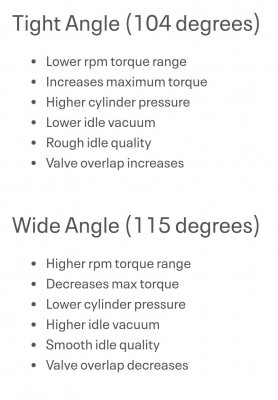I'm not sure I agree with everything on those charts. The stock cam in my V6 Buicks had a 108 LSA and idled much like our trucks do. In an all out motor, where you want to squeak out every last drop of power, it makes sense to increase lift beyond .510 and that alone, in an all out race motor, will yield about 10-20 HP tops. The heads just don't flow much more beyond that to make such worthwhile in a truck where low rpm power and durability is concerned. The stock springs are good for about .510 lift and is why most camshafts require a spring upgrade of some sort. Vacuum is not a problem with any of those camshafts. Some naturally aspirated cams in the Buick V6s only had problems feeding the brake booster when LSA was down around 104 as in your example. Maybe a larger V8 would want a little more to keep the vacuum high?
One thing not mentioned is the shape and design of the lobes themselves. You can have two camshafts from different philosophies with the exact same profile but since their lobes are different (ramp profile) the engines will behave very differently. One type may cause the valves to open and close quicker, putting more strain on the valve train for example while providing a very snappy and quick throttle response.
The 114+3 is a reference to install the camshaft 3 degrees advanced timing. This lowers the peak power band.
I don't consider myself an expert on camshafts, knowing enough to get into trouble, but long ago learned that bigger is usually not better. Fellas get all carried away by big numbers and leave a lot of power on the table. If you look up that first camshaft, it's not even made anymore, and yet it's dyno numbers rivaled those with much bigger numbers while retaining street manners, towing prowess and durability. When I had my speed shop, I made more money taking the garbage off of the cars that they'd been sold by the magazines and made them faster with more conservative modifications, working within the designers intent.
For that reason, on our 2007-2009 5.3s I like the single pattern camshafts better. We don't have VVT and with it the advantage of running a dual pattern camshaft with more duration on the exhaust side.
The Crane 1449541 is the exact same camshaft as the Vinci HD Tow Stick (MT 5-065). Crane moved to Mississippi but Vinci is still here in Florida and he has no problem talking to us over the phone. I think Mark has him on speed dial still!
@Rocket Man

